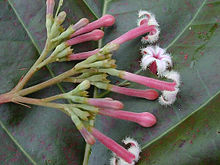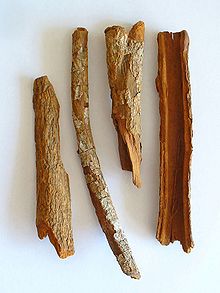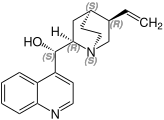China alkaloids


China alkaloids (cinchona alkaloids) are natural substances that in the cinchona occur.
Representative
There are more than 30 alkaloids in this group. The representatives also include the alkaloids quinine , quinidine , cinchonine and cinchonidine , which are structurally part of the quinoline alkaloids .
Occurrence
China alkaloids are isolated from the cinchona bark. The red, officinal “apothecary bark” contains between 4 and 12% alkaloids. The cinchona bark comes from the cinchona tree ( Cinchona officinalis ) native to South America .
|
A total of 4 - 12% china alkaloids are contained in C. officinalis . Including: |
||||
| quinine | Quinidine | Cinchonidine | Cinchonine | |
|---|---|---|---|---|
| 25% | 5% | 25% | 45% | |
use
A drug is made from the bark of Cinchona species, such as Cinchona pubescens and Cinchona calisaya . The bark is obtained from trees 6 to 8 years old.
The non-official “yellow rinds” of Cinchona calisaya are used for the technical isolation of the China alkaloids . Every year approx. 5000–10000 t of the bark are extracted from approx. 300–500 t of the main alkaloids quinine and quinidine.
properties
(-) - Quinine shows a blue-green fluorescence. It is also used as a remedy for malaria. It also has an antipyretic and analgesic effect. 10 g quinine is fatal in an adult. (-) - Quinidine has an antiarrhythmic effect.
(-) - Quinine is responsible for the bitter taste of the tonic water .
Individual evidence
- ↑ a b c d Entry on China alkaloids. In: Römpp Online . Georg Thieme Verlag, accessed on May 5, 2020.
- ↑ a b E. Breitmaier: Alkaloids . Springer Fachmedien, Wiesbaden 1997, ISBN 978-3-519-03542-8 , pp. 72 f .
- ^ Siegfried Ebel and Hermann J. Roth (editors): Lexikon der Pharmazie , Georg Thieme Verlag, 1987, ISBN 3-13-672201-9 , p. 147.
- ↑ A. Wollrab: Organic Chemistry . 3. Edition. Springer Verlag, Berlin Heidelberg 2009, ISBN 978-3-642-00781-1 , p. 1046 .





